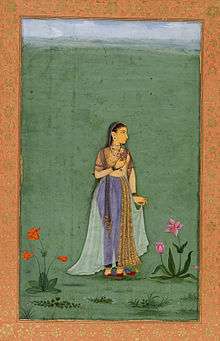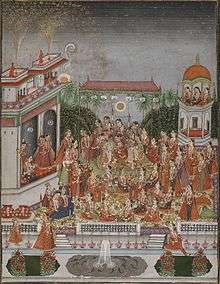Nadira Banu Begum
| Nadira Banu Begum | |
|---|---|
| Shahzadi of the Mughal Empire | |
 This portrait is thought to be of Princess Nadira Banu Begum | |
| Born |
14 March 1618 Merta, Rajasthan, India |
| Died |
6 June 1659 (aged 41) Bolan Pass, Pakistan |
| Burial | Tomb of Nadira Begum, Lahore |
| Spouse | Dara Shukoh |
| Issue |
Sulaiman Shikoh Mumtaz Shikoh Sipihr Shikoh Jahanzeb Banu Begum |
| House | Timurid (by birth) |
| Father | Sultan Parvez Mirza |
| Mother | Jahan Banu Begum |
| Religion | Islam |
Nadira Banu Begum (14 March 1618 – 6 June 1659) was a Mughal princess and the wife of Crown prince Dara Shukoh, the eldest son and heir-apparent of the fifth Mughal emperor Shah Jahan.[1] After Aurangzeb's rise to power, Dara Shukoh's immediate family and all of his supporters were in grave danger. Nadira died in 1659, several months before her husband's execution, and was survived by two sons and a daughter.
Family and lineage
Nadira Banu Begum was born a Mughal princess and was the daughter of Mughal prince Sultan Parvez Mirza,[2][3] the second son of Emperor Jahangir from his wife, Sahib-i-Jamal Begum.[4] Her mother, Jahan Banu Begum, was also a Mughal princess being the daughter of Sultan Murad Mirza, the second son of Emperor Akbar.[5] Nadira was a first-cousin of her future husband as her father, Sultan Parvez Mirza, was the older half-brother of Dara's father, Shah Jahan.[6]
Marriage

When Dara Shukoh's mother, Mumtaz Mahal, died in 1631 while giving birth to her fourteenth child, Gauhara Begum, the wedding arrangements halted as the Mughal Empire plunged into mourning and Shah Jahan was consumed in his grief. After much coaxing by many, including his favorite daughter Jahanara Begum, he resumed life as normal and let her oversee the remaining aspects of the wedding.[7]
Nadira married her first cousin, Dara Shukoh on 1 February 1633 at Agra; midst great celebrations, pomp and grandeur. The nikah ceremony was performed after midnight. By all accounts, Nadira and Dara were both devoted to each other, and Dara's love for Nadira proved to be even more faithful than that of Shah Jahan for Mumtaz Mahal — for unlike his father, he never contracted any other marriage.[7] Nadira Begum emerges in Mughal chronicles as being no less beautiful than her mother-in-law, and perhaps just as courageously loyal. She bore her husband seven children, with two sons, Sulaiman Shikoh and Sipihr Shukoh and a daughter Jahanzeb Banu Begum, surviving to play important roles in future events. Within two years of their marriage, in 1635, the handsome Sulaiman Shikoh was born; another son Sipihr Shikoh would follow in 1644 and a daughter Jahanzeb or affectionately known as Jani Begum, was born sometime afterwards.[7]
Nadira Begum wielded great influence in her husband's harem and was granted the right to issue farmans and nishans. This exceptional privilege was allowed only to those who held the highest rank in the imperial harem. The only other woman who had this right apart from Nadira Begum was her cousin and sister-in-law, Jahanara Begum.[8]
Nadira and Jahanara Begum, her cousin as well as sister-in-law, were said to have gotten on well; a fact which probably sprung from Jahanara’s involvement in her wedding and her closeness to her brother. Jahanara had consciously decided to support Dara, the most beloved to her of all of her siblings, over Aurangzeb, and she made outward demonstrations of this decision.
According to legend, Aurangzeb had fallen sick sometime during his teen years. It was at this time he called Jahanara in. He then asked her outright if she would support him in his bid for the crown. She refused. Despite how unpopular this must have made her in his sight, and her undying loyalty to her brother Dara, she went on to become the head of the harem in Aurangzeb’s court.
Jahanara’s outward declarations of love for her eldest brother no doubt strengthened the relationship between herself and his wife, and when she died, she left the cream of her fortune to one of the daughters Nadira had borne him.
Dara Shukoh was said to be a fine painter, and many of his works, when criticized, were considered to be almost of a professional standard. Some of his works were collected and gifted to Nadira Banu, and it was a token of her affection for him that she cherished it until her death, when it went on display at a museum.
Death
Nadira Begum died on 6 June 1659 of dysentery while she was accompanying her husband and family in Bolan Pass, Pakistan. She had been faithful and devoted to her husband during the hardships in his life and had shared in all his wanderings. Her death drew Dara into such a frantic state of grief that his own fate appeared a matter of indifference to him.[9]
Nadira's last wish was to be buried in India, and without considering the consequences of her request, Dara sent his deceased wife's corpse to Lahore in charge of his soldiers to be buried there.[10] The princess' tomb was built next to Mian Mir's tomb in Lahore, Pakistan, who had been the spiritual instructor of Dara Shikoh.[11]
Ancestry
| Ancestors of Nadira Banu Begum | ||||||||||||||||||||||||||||||||||||||||||||||||||||||||||||||||||||||||||||||||||||||||||||||||||||||||||||||||||||||||||||||||||||||||||||||||||||||||||||||||||||||||||||||||||||||||||||||||||||||||||||||||||||||||||||||||||||||
|---|---|---|---|---|---|---|---|---|---|---|---|---|---|---|---|---|---|---|---|---|---|---|---|---|---|---|---|---|---|---|---|---|---|---|---|---|---|---|---|---|---|---|---|---|---|---|---|---|---|---|---|---|---|---|---|---|---|---|---|---|---|---|---|---|---|---|---|---|---|---|---|---|---|---|---|---|---|---|---|---|---|---|---|---|---|---|---|---|---|---|---|---|---|---|---|---|---|---|---|---|---|---|---|---|---|---|---|---|---|---|---|---|---|---|---|---|---|---|---|---|---|---|---|---|---|---|---|---|---|---|---|---|---|---|---|---|---|---|---|---|---|---|---|---|---|---|---|---|---|---|---|---|---|---|---|---|---|---|---|---|---|---|---|---|---|---|---|---|---|---|---|---|---|---|---|---|---|---|---|---|---|---|---|---|---|---|---|---|---|---|---|---|---|---|---|---|---|---|---|---|---|---|---|---|---|---|---|---|---|---|---|---|---|---|---|---|---|---|---|---|---|---|---|---|---|---|---|---|---|---|
| ||||||||||||||||||||||||||||||||||||||||||||||||||||||||||||||||||||||||||||||||||||||||||||||||||||||||||||||||||||||||||||||||||||||||||||||||||||||||||||||||||||||||||||||||||||||||||||||||||||||||||||||||||||||||||||||||||||||
In popular culture
- Nadira Banu Begum is a principal character in Indu Sundaresan's historical novel Shadow Princess (2010).
- Nadira Banu Begum is a character in Ruchir Gupta's historical novel Mistress of the Throne (2014).
References
- ↑ Vogel, J. Hutchison, J. Ph (1994). History of the Panjab hill states. New Delhi, India: Asian Educational Services. p. 257. ISBN 9788120609426.
- ↑ Koch, Ebba (2006). The complete Taj Mahal and the riverfront gardens of Agra. Bookwise (India) Pvt. Ltd. p. 46.
- ↑ Robinson, Annemarie Schimmel ; translated by Corinne Attwood ; edited by Burzine K. Waghmar ; with a foreword by Francis (2005). The empire of the Great Mughals : history, art and culture (Revised ed.). Lahore: Sang-E-Meel Pub. p. 48. ISBN 9781861891853.
- ↑ The city in the Islamic world. Leiden [u.a.]: Brill. 2008. p. 574. ISBN 9789004171688.
|first1=missing|last1=in Authors list (help) - ↑ Bhavan's Journal. Bharatiya Vidya Bhavan. 1979. p. 78.
- ↑ Koch, Ebba (2006). The complete Taj Mahal and the riverfront gardens of Agra. Bookwise (India) Pvt. Ltd. p. 46.
- 1 2 3 Hansen, Waldemar (1972). The Peacock throne : The Drama of Mogul India (1. Indian ed., repr. ed.). Motilal Banarsidass. p. 121. ISBN 9788120802254.
- ↑ Misra, Rekha (1967). Women in Mughal India, 1526-1748 A.D. Munshiram Manoharlal. p. 67.
- ↑ Edwardes, S. M.; Garrett, H. L. O. (1995). Mughal Rule in India. Atlantic Publishers and Distributors. p. 96. ISBN 9788171565511.
- ↑ Bernier, Francois (1996). Travels in the Mogul Empire. Asian Educational Services. p. 103. ISBN 8120611691.
- ↑ Schimmel, Annemarie (1963). Gabriel's Wing: A Study Into the Religious Ideas of Sir Muhammad Iqbal. Brill Archive. p. 9.